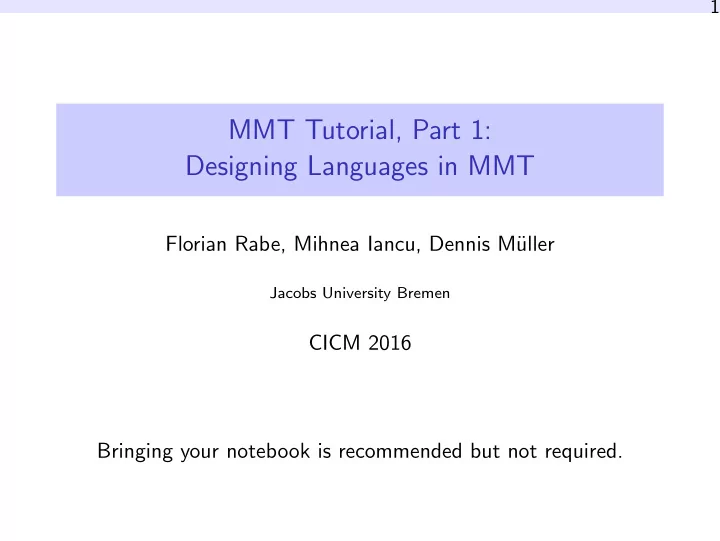

1 MMT Tutorial, Part 1: Designing Languages in MMT Florian Rabe, Mihnea Iancu, Dennis M¨ uller Jacobs University Bremen CICM 2016 Bringing your notebook is recommended but not required.
Structure of the Tutorial 2 Overview 1. Brief introduction to MMT 2. Download, install MMT and MMT IDE 3. Design languages in MMT 3.1 LF as an example of a logical framework LF 3.2 FOL as an example of a formal language 3.3 algebraic theories as examples of domain knowledge 3.4 module system for algebra 3.5 design logics modularly 3.6 implement logical frameworks modularly
Structure of the Tutorial 3 Further Resources ◮ MMT homepage: http://uniformal.github.io/ ◮ Introductory articles: http: //uniformal.github.io/doc/philosophy/intros.html ◮ Publications: http: //uniformal.github.io/doc/philosophy/papers.html ◮ Sources: http://uniformal.github.io/MMT ◮ API documentation: http://uniformal.github.io/apidoc
Motivation of MMT 4 Language-Independence MMT = meta-meta-theory/tool a universal framework for the formal representation of all knowledge and its semantics in math, logic, and computer science ◮ Avoid fixing languages wherever possible ◮ Use formal meta-languages for defining languages . . . ◮ . . . and avoid fixing even the meta-languages. Obtain (meta-)language-independent results Mathematics Formalization Logical Language- Framework Independence meta-meta- framework meta-language language (logics, DSLs, etc.) domain knowledge
Motivation of MMT 5 Subsume All Paradigms of Knowledge Representation ◮ Conceptualization: identifiers and their properties ◮ Narration: human-oriented, informal-but-rigorous ◮ Deduction: machine-verificable, formal ◮ Computation: executable, algorithmic ◮ Tabulation: databases, queryable Tabulation Deduction Concepts Computation Narration
Motivation of MMT 6 Design Principles Separation of concerns between ◮ language development logical primitives, rules ◮ knowledge management e.g., search, change management ◮ verification e.g., type checking, theorem prover ◮ application development e.g., IDE, proof assistant Universal language ◮ few primitives . . . ◮ that unify different domain concepts Language-Independent Implementations ◮ possible for surprisingly many results ◮ yields rapid prototyping for logic systems
Motivation of MMT 7 The Meta-Hierarchy of Languages ◮ Languages at all meta-level uniformly represented as MMT theories ◮ Same module system at all levels MMT LF+X LF LATIN logic library HOL Light Mizar . . . HOL Light library Bool Arith Arith XBoole XReal . . . . . . . . . Mizar library
Motivation of MMT 8 Language-Independent Results So Far Knowledge Management ◮ Change management recheck only if affected ◮ Project management indexing, hosting ◮ Extensible build system presentation, import/export, . . . ◮ Search, querying substitution-tree and relational index ◮ Browser interactive web browser ◮ Editing IDE-like graphical interface Logical Results ◮ Module system modularity transparent to foundation developer ◮ Concrete/abstract syntax notation-based parsing/presentation ◮ Type reconstruction foundation plugin supplies only core rules ◮ Simplification rule-based, integrated with type reconstruction ◮ Anticipated: Theorem proving, code generation, stateful computation
Motivation of MMT 9 MMT is Not a Stand-alone System ◮ MMT and all the above results implemented as a Scala library mmt.jar ◮ Execution of raw MMT possible as ◮ an interactive shell ◮ an script interpreter ◮ an HTTP server ◮ But main use as component in other applications See Part 2 of the tutorial ◮ One particular application: MMT IDE based on jEdit We’ll use that one in Part 1
Motivation of MMT 10 Let’s Start ◮ I will work through the tutorial on the screen ◮ You should follow on your computers ◮ Main link: http: //uniformal.github.io/doc/tutorials/prototyping/ no need to type this — these slides are linked from the CICM program
Recommend
More recommend